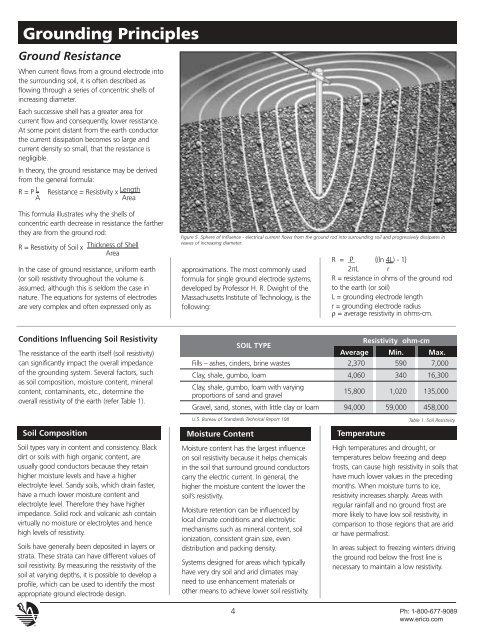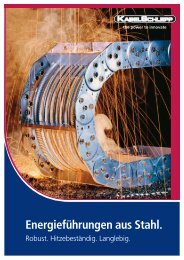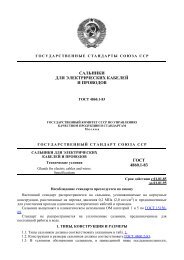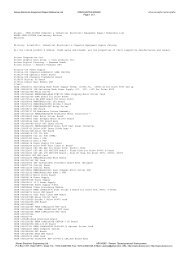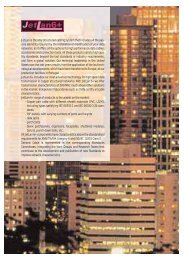Grounding Products and Systems - Elec.ru
Grounding Products and Systems - Elec.ru
Grounding Products and Systems - Elec.ru
- No tags were found...
You also want an ePaper? Increase the reach of your titles
YUMPU automatically turns print PDFs into web optimized ePapers that Google loves.
<strong>Grounding</strong> PrinciplesGround ResistanceWhen current flows from a ground electrode intothe surrounding soil, it is often described asflowing through a series of concentric shells ofincreasing diameter.Each successive shell has a greater area forcurrent flow <strong>and</strong> consequently, lower resistance.At some point distant from the earth conductorthe current dissipation becomes so large <strong>and</strong>current density so small, that the resistance isnegligible.In theory, the ground resistance may be derivedfrom the general formula:R = P L Resistance = Resistivity x LengthAAreaThis formula illustrates why the shells ofconcentric earth decrease in resistance the fartherthey are from the ground rod:R = Resistivity of Soil xThickness of ShellAreaIn the case of ground resistance, uniform earth(or soil) resistivity throughout the volume isassumed, although this is seldom the case innature. The equations for systems of electrodesare very complex <strong>and</strong> often expressed only asFigure 5. Sphere of Influence - electrical current flows from the ground rod into surrounding soil <strong>and</strong> progressively dissipates inwaves of increasing diameter.approximations. The most commonly usedformula for single ground electrode systems,developed by Professor H. R. Dwight of theMassachusetts Institute of Technology, is thefollowing:R = __ ρ {(ln 4L) - 1}2πL rR = resistance in ohms of the ground rodto the earth (or soil)L = grounding electrode lengthr = grounding electrode radiusρ = average resistivity in ohms-cm.Conditions Influencing Soil ResistivityThe resistance of the earth itself (soil resistivity)can significantly impact the overall impedanceof the grounding system. Several factors, suchas soil composition, moisture content, mineralcontent, contaminants, etc., determine theoverall resistivity of the earth (refer Table 1).SOIL TYPEResistivity ohm-cmAverage Min. Max.Fills – ashes, cinders, brine wastes 2,370 590 7,000Clay, shale, gumbo, loam 4,060 340 16,300Clay, shale, gumbo, loam with varyingproportions of s<strong>and</strong> <strong>and</strong> gravel15,800 1,020 135,000Gravel, s<strong>and</strong>, stones, with little clay or loam 94,000 59,000 458,000Soil CompositionSoil types vary in content <strong>and</strong> consistency. Blackdirt or soils with high organic content, areusually good conductors because they retainhigher moisture levels <strong>and</strong> have a higherelectrolyte level. S<strong>and</strong>y soils, which drain faster,have a much lower moisture content <strong>and</strong>electrolyte level. Therefore they have higherimpedance. Solid rock <strong>and</strong> volcanic ash containvirtually no moisture or electrolytes <strong>and</strong> hencehigh levels of resistivity.Soils have generally been deposited in layers orstrata. These strata can have different values ofsoil resistivity. By measuring the resistivity of thesoil at varying depths, it is possible to develop aprofile, which can be used to identify the mostappropriate ground electrode design.U.S. Bureau of St<strong>and</strong>ards Technical Report 108Moisture ContentMoisture content has the largest influenceon soil resistivity because it helps chemicalsin the soil that surround ground conductorscarry the electric current. In general, thehigher the moisture content the lower thesoil’s resistivity.Moisture retention can be influenced bylocal climate conditions <strong>and</strong> electrolyticmechanisms such as mineral content, soilionization, consistent grain size, evendistribution <strong>and</strong> packing density.<strong>Systems</strong> designed for areas which typicallyhave very dry soil <strong>and</strong> arid climates mayneed to use enhancement materials orother means to achieve lower soil resistivity.TemperatureTable 1. Soil Resistivity.High temperatures <strong>and</strong> drought, ortemperatures below freezing <strong>and</strong> deepfrosts, can cause high resistivity in soils thathave much lower values in the precedingmonths. When moisture turns to ice,resistivity increases sharply. Areas withregular rainfall <strong>and</strong> no ground frost aremore likely to have low soil resistivity, incomparison to those regions that are aridor have permafrost.In areas subject to freezing winters drivingthe ground rod below the frost line isnecessary to maintain a low resistivity.4 Ph: 1-800-677-9089www.erico.com


